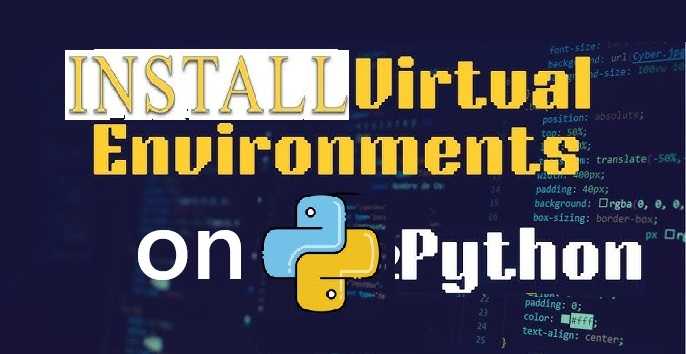If you’re a Python developer, one of the most important concepts you’ll need to understand is virtual environments. Python’s flexibility is fantastic, but it can also cause issues when managing dependencies for different projects. For example, what happens if one project requires version 1 of a library, while another project needs version 2? This is where virtual environments come to the rescue.
In this article, we’ll explain what virtual environments are, why they are important, and guide you through the usage and install virtual environment on Python. By the end of this guide, you’ll be able to create, manage, and use virtual environments effectively, which will streamline your workflow and avoid dependency conflicts.
What is a Virtual Environment on Python?
Before we dive into the installation process, let’s first understand what a virtual environment is and why it’s useful.
A virtual environment in Python is a self-contained directory that contains a Python installation for a particular version of Python, along with additional packages that you install. It allows you to create isolated environments for each of your Python projects, ensuring that dependencies for one project don’t affect another.
Benefits of Using Virtual Environments:
- Avoiding Dependency Conflicts: Virtual environments isolate dependencies, so you don’t have to worry about version conflicts between packages in different projects.
- Easier Package Management: With virtual environments, you can manage the dependencies for each project independently.
- Clean Development Setup: Virtual environments prevent your global Python setup from becoming cluttered with unnecessary libraries and dependencies.
- Reproducibility: Virtual environments help ensure that your projects can be easily reproduced on different machines without versioning issues.
Overall, using virtual environments makes it easier to maintain clean, reproducible, and manageable Python projects.
Prerequisites for Installing Virtual Environments
Before you begin installing virtual environments, make sure you have the following:
- Python Installed: A virtual environment depends on Python, so ensure you have Python installed on your system.
- To check if Python is installed, open a terminal (or Command Prompt on Windows) and type:
python --versionor for Python 3.x:python3 --version
- To check if Python is installed, open a terminal (or Command Prompt on Windows) and type:
- Package Manager (pip):
pipis Python’s package manager, and it should be included in your Python installation. It is essential for installing virtual environment tools.- You can check if
pipis installed by running:pip --version
- You can check if

How to Install Virtual Environment on Python?
Now that you have the prerequisites, let’s go through the process of installing and using virtual environments on different operating systems.
Installing Virtual Environment on Windows
On Windows, the steps are relatively straightforward. Here’s how you can install and set up a virtual environment:
Step 1: Install virtualenv (Optional)
While Python 3.3 and later come with a built-in module for virtual environments called venv, some developers prefer to use the virtualenv package, as it offers additional features and customization options.
To install virtualenv, open your Command Prompt and type:
pip install virtualenv
Step 2: Create a Virtual Environment Using venv
You can use Python’s built-in venv module to create a virtual environment. Here’s how:
- Open Command Prompt.
- Navigate to your project directory:
cd path\to\your\project - To create a virtual environment, run:
python -m venv venvThis will create a directory namedvenvin your project folder, which will contain the isolated Python environment.
Step 3: Activate the Virtual Environment
After creating the virtual environment, you need to activate it:
- In Command Prompt, run:
.\venv\Scripts\activateAfter activation, your prompt should change to show the name of the virtual environment (e.g.,(venv)).
Step 4: Install Packages Inside the Virtual Environment
Once your virtual environment is activated, you can install packages using pip, and those packages will be installed only within that environment:
pip install <package-name>
Step 5: Deactivate the Virtual Environment
When you’re done working, you can deactivate the virtual environment by typing:
deactivate
This will return you to your global Python environment.
Installing Virtual Environment on macOS
On macOS, setting up a virtual environment is similar to Windows, but with some slight differences. Here’s how you can install and use virtual environments:
Step 1: Install virtualenv (Optional)
If you want to use the virtualenv tool instead of venv, install it via pip:
pip install virtualenv
Step 2: Create a Virtual Environment Using venv
- Open Terminal.
- Navigate to your project directory:
cd /path/to/your/project - Run the following command to create a virtual environment:
python3 -m venv venvThis will create a directory calledvenvcontaining the virtual environment.
Step 3: Activate the Virtual Environment
To activate the virtual environment in macOS, use the following command:
source venv/bin/activate
After activation, your terminal prompt should show the virtual environment’s name.
Step 4: Install Packages Inside the Virtual Environment
With the virtual environment activated, you can now install packages:
pip install <package-name>
Step 5: Deactivate the Virtual Environment
When finished, deactivate the virtual environment:
deactivate
Installing Virtual Environment on Linux
The process of creating and managing virtual environments on Linux is very similar to macOS. Follow these steps:
Step 1: Install virtualenv (Optional)
To install the virtualenv package, use the following command:
pip install virtualenv
Step 2: Create a Virtual Environment Using venv
- Open Terminal.
- Navigate to your project directory:
cd /path/to/your/project - Create a virtual environment:
python3 -m venv venvThis creates avenvdirectory containing the virtual environment.
Step 3: Activate the Virtual Environment
Activate the virtual environment with:
source venv/bin/activate
Once activated, your terminal prompt should display the name of the virtual environment.
Step 4: Install Packages Inside the Virtual Environment
With the virtual environment active, you can install packages:
pip install <package-name>
Step 5: Deactivate the Virtual Environment
To deactivate, simply type:
deactivate
Managing Dependencies with Virtual Environments
One of the most useful features of virtual environments is the ability to manage project dependencies. Let’s look at how you can export and import dependencies using pip:
Creating a requirements.txt File
You can create a requirements.txt file, which lists all the installed packages and their versions, to make it easier to replicate the environment on another machine.
- With the virtual environment activated, run the following command:
pip freeze > requirements.txtThis will generate arequirements.txtfile containing all the installed dependencies.
Installing Dependencies from requirements.txt
To install the dependencies listed in a requirements.txt file, run the following command:
pip install -r requirements.txt
This will install all the packages listed in the requirements.txt file into the active virtual environment.
Troubleshooting Virtual Environment Installation Issues
While the installation process for virtual environments is generally smooth, you may encounter some issues. Here are a few common problems and how to resolve them:
1. Command Not Found (Windows)
If you see an error like 'python' is not recognized as an internal or external command, you may need to add Python to your system’s PATH variable. To do this, reinstall Python and ensure you check the box to add Python to the PATH during the installation process.
2. Permission Denied Errors (macOS/Linux)
If you encounter permission issues when installing packages, try using sudo to install the packages with elevated privileges:
sudo pip install <package-name>
3. Virtualenv Not Found
If you’re trying to use virtualenv and it’s not found, install it using pip:
pip install virtualenv
Conclusion
In this comprehensive guide, we’ve walked through the process of install virtual environment on Python. By using virtual environments, you can manage your Python projects in isolated, self-contained spaces, avoiding dependency conflicts and ensuring that your development environment remains clean and organized.
Key Takeaways:
- Virtual environments are essential for managing project dependencies.
- Python’s built-in
venvmodule and the externalvirtualenvtool allow you to create virtual environments easily. - Managing dependencies with
requirements.txtsimplifies collaboration and project sharing.
Now that you know how to set up virtual environments on Windows, macOS, and Linux, it’s time to start using them in your projects. Happy coding!
If you found this guide helpful, feel free to share it with fellow Python enthusiasts or beginners who are just starting their development journey. Don’t forget to leave a comment or ask questions below! Explore more articles on Python programming to deepen your knowledge and expand your coding skills.
Read Also : How to Install Tkinter on Python?







